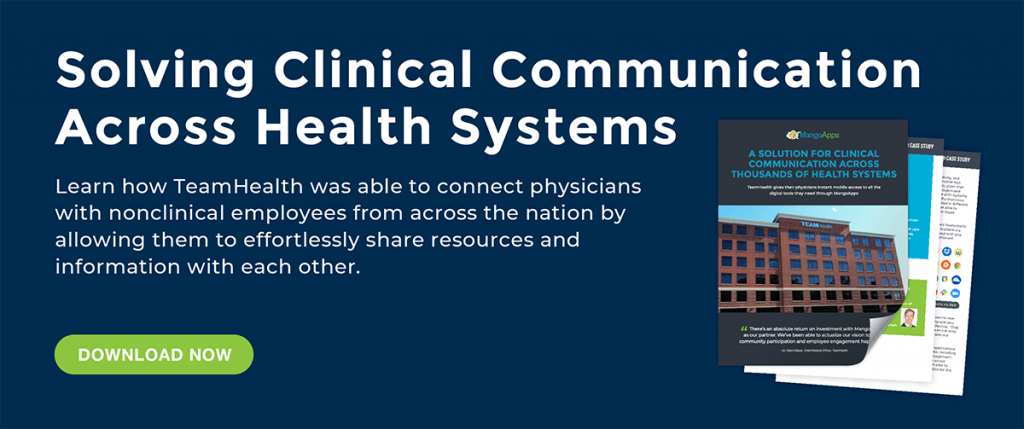In today’s evolving healthcare landscape, fostering robust physician engagement strategies is critical for health system administrators.
It’s more than just a buzzword—it’s a transformative approach that bolsters both individual performance and overall organizational health. Implementing thoughtful, effective physician engagement strategies can lead to improved patient care, increased staff satisfaction, and ultimately, a more robust bottom line.
But where should administrators start? What are the keys to a successful physician engagement strategy? In this comprehensive guide, we’ll delve into the nuances of physician engagement, offering insights and practical tips to help you unlock the full potential of your healthcare team.
By understanding and implementing these strategies, you can ensure that your health system remains at the forefront of patient care in an ever-competitive, increasingly complex field.
Understanding the Value of Physician Engagement
Before we dive into specific physician engagement strategies, let’s first understand its value and its impact on your health system. Physician engagement refers to the level of commitment and involvement a physician has towards their organization and its values. When physicians are actively engaged, they are more likely to contribute towards the organization’s goals and deliver high-quality patient care.
Research has consistently linked high levels of physician engagement to improved patient outcomes, reduced errors, and higher patient satisfaction scores. A study published in Health Care Management Review found that hospitals with high levels of physician engagement had 26% higher patient satisfaction scores and significantly lower patient mortality rates (source).
Furthermore, engaged physicians are less likely to experience burnout, a growing concern within the healthcare sector that can lead to increased turnover rates, decreased quality of care, and a negative impact on the bottom line. Engaged physicians exhibit higher job satisfaction, which can also lead to lower turnover rates, creating a more stable, cohesive team.
Now that we have established the value of physician engagement, we can start to explore various strategies to enhance it in your health system. It’s important to remember that there isn’t a ‘one-size-fits-all’ approach to physician engagement. Therefore, strategies must be tailored to the unique needs and circumstances of your organization and its team members.

The Current Landscape: Challenges in Physician Engagement
The evolving dynamics of healthcare reforms, the rise of patient-centric care, and increasing financial pressures contribute to the complexities of fostering physician engagement.
Moving Towards Value-Based Care
The shift from volume-based to value-based care has placed enormous pressure on physicians to deliver high-quality care while managing costs. This requires a level of engagement that goes beyond patient care. Physicians now need to play an active part in the management and decision-making processes of their organizations.
Technological Advancements
The rapid advancement of technology in healthcare has created another layer of complexity. While digital tools offer potential to streamline operations and enhance patient care, they also require physicians to adapt and learn new systems. This can lead to frustration and resistance if not managed appropriately, hindering engagement.
Administrative Burden
Increasing administrative burden is another significant challenge. Physicians often find themselves caught up in paperwork and bureaucratic tasks, which detract from their primary role of patient care. This can be a major deterrent to physician engagement, as it results in burnout and dissatisfaction.
Outdated Compensation Models
The current compensation models in many health systems do not necessarily encourage physician engagement. Often, these models are centered around patient volumes and services provided rather than quality of care or physician participation in organizational initiatives. This can discourage physicians from becoming engaged in their organizations beyond their clinical roles.
To overcome these challenges and pave the way for enhanced physician engagement, health system administrators need to address these issues head-on. By understanding the unique hurdles that physicians face, administrators can devise more effective, tailored physician engagement strategies. We will delve deeper into these strategies in the subsequent sections of this guide.
Five Key Physician Engagement Strategies
1. Open Communication Channels
Ensuring open and transparent communication is the foundation of successful physician engagement strategies. Administrators should foster a culture where physicians feel comfortable expressing their ideas, concerns, and suggestions without fear of negative consequences.
For example, here are some ways to encourage open communication:
Regular Meetings and Discussions
Organize regular meetings where physicians can discuss clinical and administrative issues openly. These meetings should not be a one-way communication from administrators to physicians; rather, they should be an opportunity for dialogue, collaboration, and problem-solving.
Feedback Mechanisms
Set up reliable feedback mechanisms, such as surveys and suggestion boxes, to collect physicians’ inputs on various issues. Feedback should be anonymous to encourage honest responses. Make sure to act on this feedback and communicate any changes or actions back to the physicians.
This can also help to surface the signs of physician burnout and help you understand and address them.
Transparency
Be transparent about organizational changes, challenges, and strategies. By keeping physicians in the loop, they’ll feel more invested in the organization and its success. Furthermore, this transparency should extend to financial matters—physicians should understand how their work affects the organization’s bottom line.
Leadership Accessibility
Leaders should be accessible and approachable. This includes the CEO, CMO, and other executive leadership. When physicians feel their leaders are accessible and willing to listen to their concerns, it fosters trust and increases engagement.
In summary, open communication channels ensure physicians feel heard and valued. This not only improves their job satisfaction but also makes them more willing to contribute to organizational initiatives and improvements.
2. Provide Adequate Training and Support
Providing sufficient training and support is essential in fostering physician engagement. With the rapid advancements in healthcare technology and the increasing complexity of healthcare delivery, physicians must continually upgrade their skills and knowledge. This is where targeted training and support programs come in. These programs not only help physicians keep up with industry changes, but also show them that the organization values their professional growth and development.
Skill-Based Training
Providing regular skill-based training helps physicians improve their clinical skills and adapt to new treatment modalities. This includes training for new medical technologies, advanced treatment procedures, and updated clinical guidelines. Skill-based training should be relevant to the physician’s specialty and role within the organization.
Technology Training
As previously mentioned, technology plays a vital role in modern healthcare. However, the adoption and effective use of this technology depend heavily on appropriate training. Health systems should provide comprehensive tech training that covers Electronic Health Records (EHR), telemedicine platforms, and other relevant digital tools. It’s not enough to merely introduce new technology; physicians must be trained to use it efficiently and effectively.
Leadership Development
Physicians in leadership roles or those who aspire to such roles would benefit from leadership development programs. These programs can help physicians develop skills in areas such as strategic planning, decision-making, team management, and conflict resolution. By investing in leadership development, health systems can cultivate a pool of physician leaders who can guide and motivate their peers.
Supportive Environment
Beyond training, health systems should create a supportive work environment that reduces stress and prevents burnout. For example, this can involve providing resources for mental health support, creating a balanced workload, and offering flexible work hours where feasible. A supportive environment fosters a positive work culture, leading to improved physician engagement.
Continuing Medical Education (CME)
By supporting physicians in their continuing medical education, health systems show they value and invest in their staff’s professional growth. CME can keep physicians abreast of the latest medical research and practices, ensuring they provide the best possible care to their patients.
In conclusion, robust training and support mechanisms can significantly boost physician engagement. By investing in their professional growth and well-being, health systems can foster a committed and motivated physician workforce.
3. Simplifying Workflow with Integrated Tech Solutions
The efficiency of a physician’s workflow plays a significant role in determining their level of engagement. Inefficiencies such as cumbersome processes and outdated technology can lead to frustration and disengagement. Therefore, health systems must strive to streamline and simplify the workflow through integrated technological solutions—this is one of the many benefits of digital transformation for health systems.
Interoperable Systems
One of the major pain points for physicians is dealing with disparate systems that do not communicate with each other. Interoperable systems can eliminate this concern by allowing different healthcare technologies to exchange and make use of the information seamlessly. This can improve areas such as coordination of care, reduce medical errors, and save physicians’ time. A great place to start on building this ecosystem is a HIPAA-compliant intranet.
AI and Machine Learning
Artificial intelligence and machine learning technologies have the potential to transform healthcare delivery and drastically simplify physicians’ workflow. For example, AI can assist in diagnostics, predictive analytics, risk stratification, and personalized patient care plans. Moreover, machine learning algorithms can help in analyzing large volumes of data to derive meaningful insights, assisting physicians in making evidence-based decisions.
Data Analysis Tools
Lastly, advanced data analysis tools can help physicians understand their performance metrics and identify areas for improvement. These tools can provide real-time, actionable insights, helping physicians enhance their quality of care and patient outcomes.
By simplifying workflow with the right tech solutions, health systems can reduce administrative burdens on physicians, giving them more time for direct patient interaction and care. This can significantly improve physicians’ job satisfaction, leading to higher engagement and retention rates.
4. Involve Physicians in Decision Making
Physicians are key stakeholders in any healthcare institution, and their involvement in decision-making processes can greatly enhance their engagement. When physicians feel that their expertise and opinions are valued, they are more likely to commit to implementing the decisions made. Here are some strategies that health systems can adopt to involve physicians in decision-making.
Medical Committees and Boards
One effective strategy is to involve physicians in medical committees and boards. These platforms allow physicians to actively engage in discussions about the institution’s policies, procedures, and strategies. They also provide a formal means for physicians to voice their concerns, suggestions, or feedback. Thus, they make physicians feel part of the organization’s larger mission and goals.
Strategic Planning
Including physicians in strategic planning sessions can also foster engagement. This allows physicians to contribute to the institution’s long-term vision and direction. They can bring valuable insights from the frontline, helping to address practical challenges and improve service delivery.
Physician Leadership
Establishing physician leadership roles is another way to involve physicians in decision-making. Physician leaders can serve as a bridge between the administration and the medical staff. They can convey the concerns and suggestions of their fellow physicians to the administration, and vice versa. This can lead to more informed and effective decision-making.
Collaborative Decision Making
Finally, adopting a collaborative decision-making approach can also boost physician engagement. This approach involves discussing key decisions with physicians, considering their perspectives, and reaching a consensus. By involving physicians in these critical decisions, the organization can ensure that the decisions made are practical, beneficial, and likely to be well-received by the medical staff.
In conclusion, involving physicians in decision-making can significantly improve their engagement. It gives them a sense of ownership and responsibility, makes them feel valued, and can lead to better decisions that are tailored to the needs of the physicians and the patients they serve.
5. Recognize and Reward Engaged Behavior
Recognition and rewarding engaged behavior is a crucial component of comprehensive physician engagement strategies. When physicians feel appreciated and see their efforts recognized, they are more likely to feel satisfied and stay motivated in their roles. Here are some strategies that can be implemented to recognize and reward engaged behavior:
Performance Recognition
Regularly acknowledging physicians for their hard work and dedication can boost their morale and motivation. This can be done through public recognition in meetings or digital communication platforms, or through private feedback sessions. Highlighting specific achievements, such as exceptional patient outcomes, research contributions, or community service, can encourage physicians to continue these positive behaviors.
Read more about building hospital recognition programs.
Financial Incentives
Offering financial incentives based on performance metrics can be effective in fostering engagement. These could include bonuses for meeting certain quality or efficiency benchmarks, or for implementing innovative practices that improve patient care. However, it’s important for health systems to ensure these incentives are fair, transparent, and linked to measurable outcomes.
Professional Development Opportunities
Rewards do not always have to be financial. Offering opportunities for professional development, such as access to advanced training, leadership roles, or research opportunities, can also be a powerful incentive. These rewards can stimulate intellectual engagement and demonstrate the organization’s commitment to its physicians’ career growth.
Work-Life Balance Initiatives
Lastly, consider rewarding physicians with initiatives that support work-life balance. This could include flexible scheduling, resources for physical and mental wellness, or additional vacation time. These initiatives can enhance physicians’ job satisfaction and overall well-being, which can in turn lead to higher engagement levels.
In conclusion, recognizing and rewarding engaged behavior can significantly enhance physician engagement. By appreciating their efforts, offering incentives linked to positive outcomes, and supporting their professional growth and work-life balance, health systems can cultivate a motivated and committed physician workforce. This, in turn, can lead to improved patient care, better health outcomes, and a stronger, more resilient healthcare system.

Boosting engagement at Columbia Basin Health Association
Learn how CBHA got over 90% user adoption and improved staff alignment with MangoApps
Conclusion
The essence of healthcare is its humanity, with physicians at its heart. As health systems navigate the modern challenges, embracing physician engagement strategies will not only uplift the morale of the medical community but will also mold the future of healthcare into one that’s collaborative, efficient, and patient-centric.
Embrace the future by prioritizing the well-being and involvement of the physician community, and witness the transformative impact it can bring to the broader healthcare spectrum.
To learn more, read our ideas for healthcare employee engagement or learn about MangoApps’ employee app and intranet for healthcare.







